[ page 3 ]
1/32 scale model: Kitty Hawk T-28 B/D Trojan
ADDING THE DETAILS
page 2
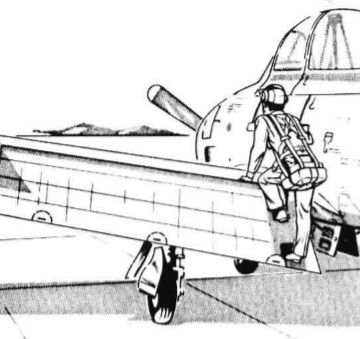
I wanted the two large single hinged flaps drooped down. To get 2 strong flap fixes, I drilled some holes in the leading edge and used metal pins to get a strong joint.
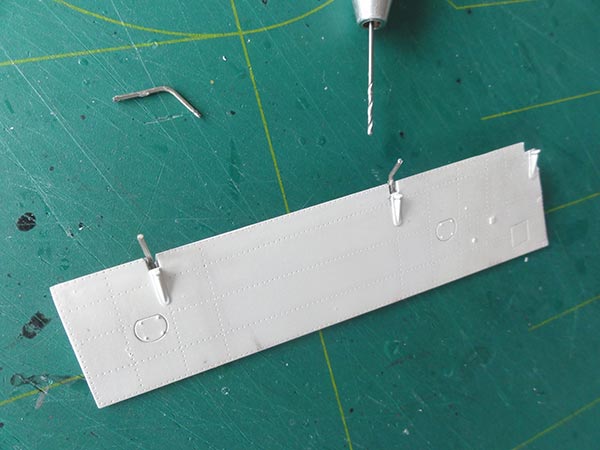
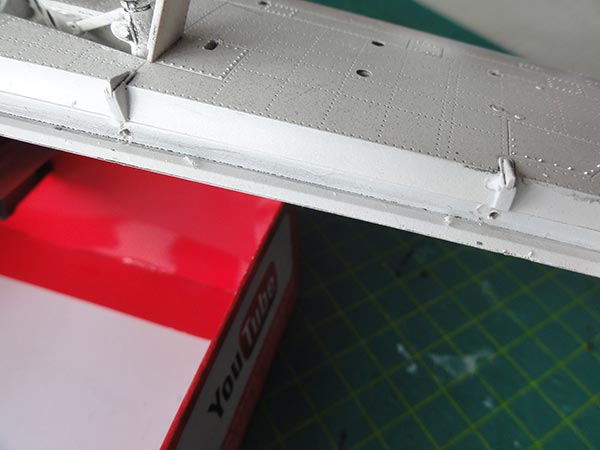
When deployed down at quite a large angle, a gap is created between the rear wing spar and flap leading edge. In this area many brackets and details are seen such as aileron cables. I made these details from scratch plastic.
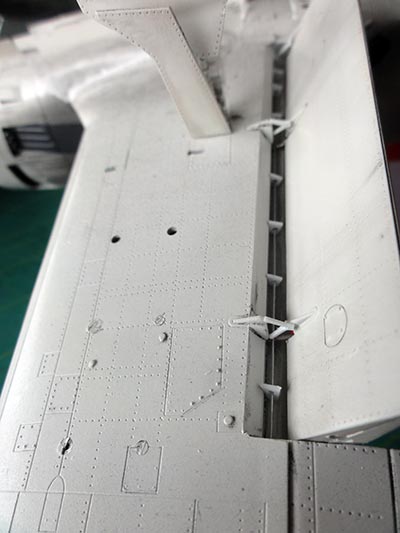
The landing gears are next. The kit parts look great though the gear is simple on a real T-28. For a T-28B, wheel hub kit parts F19 and F10 were used. The gear doors are fine and accurate, it just takes some time to figure out what their positions are, so check photos at the IPMS NL Walk arounds (see references on page 1).
On each main gear leg, a brake hydraulics line was added made from metal wire. Inside the main bays, some hydraulics tubing was added as well from scratch.
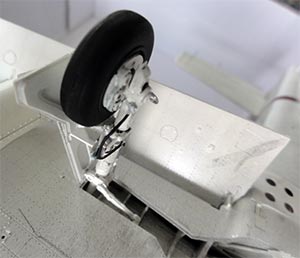
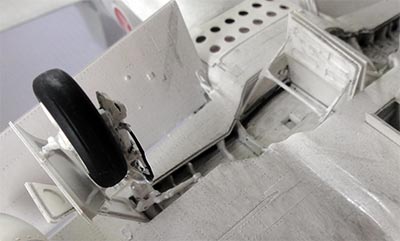
( Note the weathering applied on this T-28 flown in the jungle airfields in Laos ).
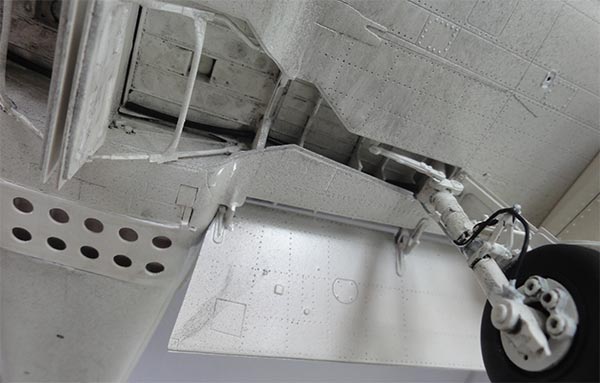
STEP 4
The nose gear leg looks great as per kit, see instructions Step 4. Note: the F83 part is not F83 but F84 and is an actuator.
The heavy balancing weights needed in the nose will for sure give problems with strength of the nose gear leg F58. I decided to avoid problems and up front strengthened the fork with a piece of metal rod. This was made from a paperclip, bended in shape and than super glued at the rear of the fork. White glue closed the gaps and when painted white it looks fine.
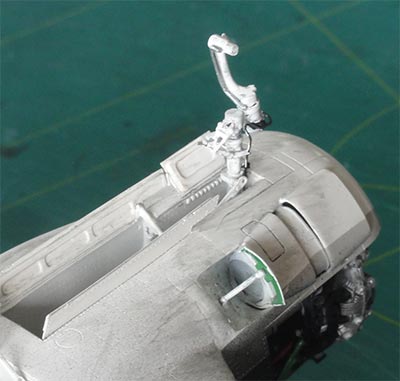

Inside the nose wheel bay I added some additional rods and details, again looking at the IPMS NL walk around photos.
The thin nose wheel picked for the T-28B were kit parts F28 + F30. Some filler was needed to close the gaps between the wheel halves. I also added 3 tiny drain pipes next to the gear bay (red coloured).
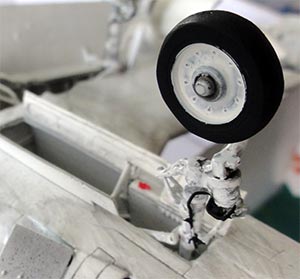
Back to Step 1: COCKPIT
The cockpit interior is light grey with black details for instruments and panels. The main instrument panels were fitted with their coamings. (for a later version of an armed T-28 you may need to add a gun sight). Some additional detailing was done in the cockpit such as adding the 2 throttles on above the left console that are surprisingly missing in the kit!
Some additional levers and bits were fitted as well.
Here a right console drawing from the real T-28 manual:

I also made the stick handles a bit thicker as the kit parts B38+B39 are a bit thin. Here a flight manual drawing:
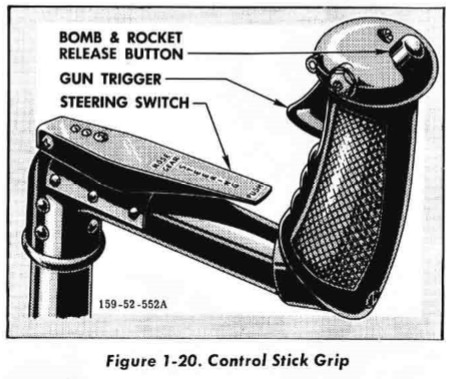
The wind screen got a mirror from a REHEAT etched metal set. Also I added an artificial horizon indicator made from scrap. The wind screen fit needs a bit white glue to close the fuselage gaps. I also added the "dirt" as per air flow as on the rest of the airframe as on the outsides of the canopy hoods.
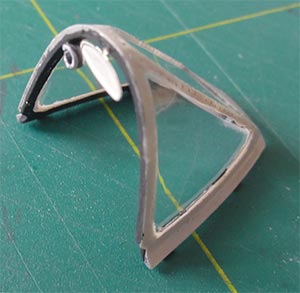
The seats in the kit are the standard non-armoured version (such as the T-28B) and are fine. A nice etched metal fret with harnesses and straps are provided in the kit. These were painted first brown and grey in the fret and applied. The buckles were painted metal. It looks great.
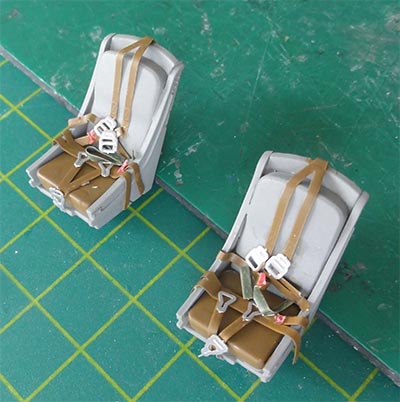
The seats were simple installed after I removed the small bottom locating lug.
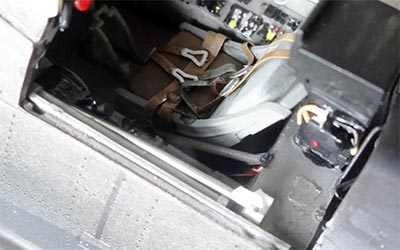
At the aft cockpit bulkhead I saw a bit late a few deepened holes. A piece of card as added with these cut in and painted black. (for your model, make these holes earlier in the rear wall).
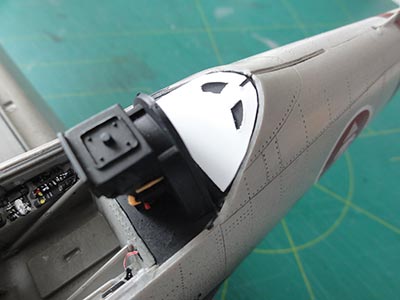
Inside the rear canopy hood it seems a sort of cover is fitted with a sliding bracket. This was made from card and to be painted black. I also added the opening handle. (no sun shade screen was added, but sometimes T-28 have these as well; these are separate removable screens)
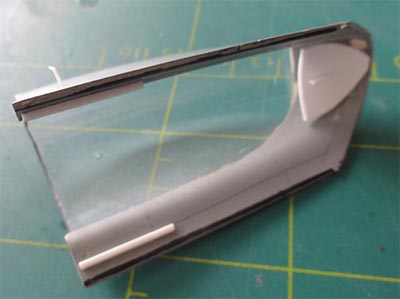
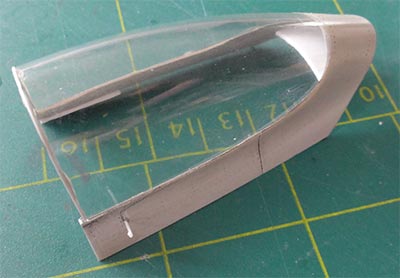
The canopy hoods slide to the rear. For the forward pilot hood 2 metal bars (with cables inside) are seen at the cockpit sides of a real T-28 that significantly raises the hood when slided aft. At the rear, only at the left cockpit side a metal bar is seen. In the kit, Kitty Hawk suggests these with engraved detail but they are too small. So 3 bars were made from metal rod with some brackets made from card.
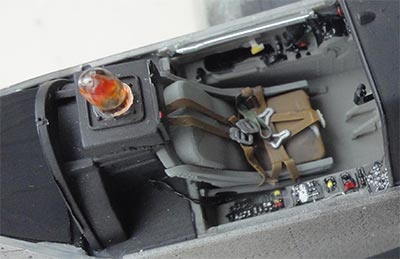

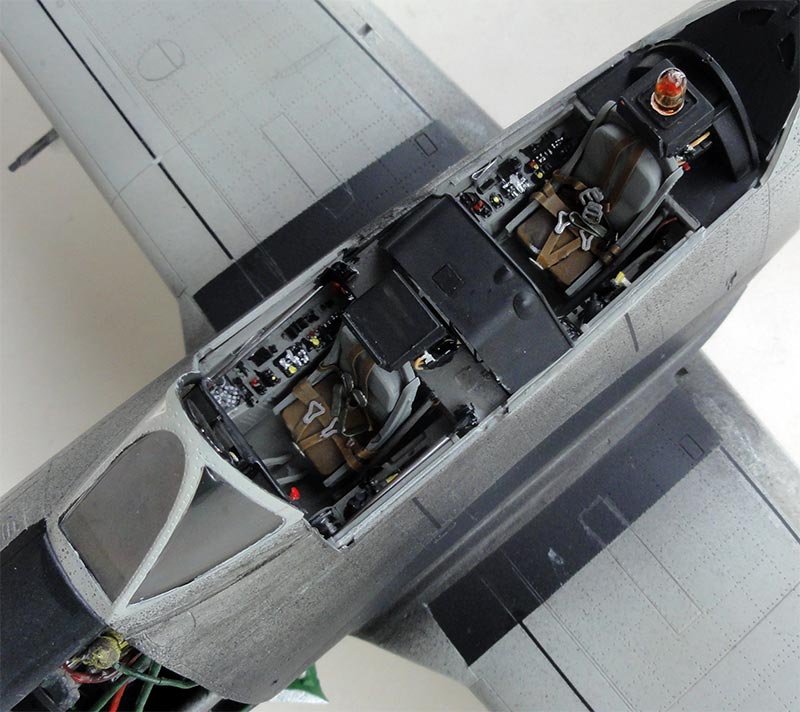
Inside the canopy hoods some strips were added to meet the sliding brackets at the metal rods.
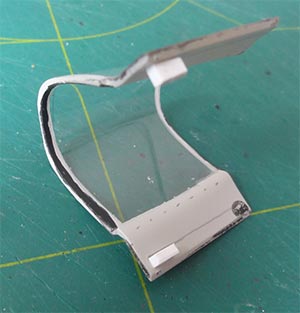
The hoods were set in place. Note that the forward canopy hood tilts upwards in front and thus is at an angle.
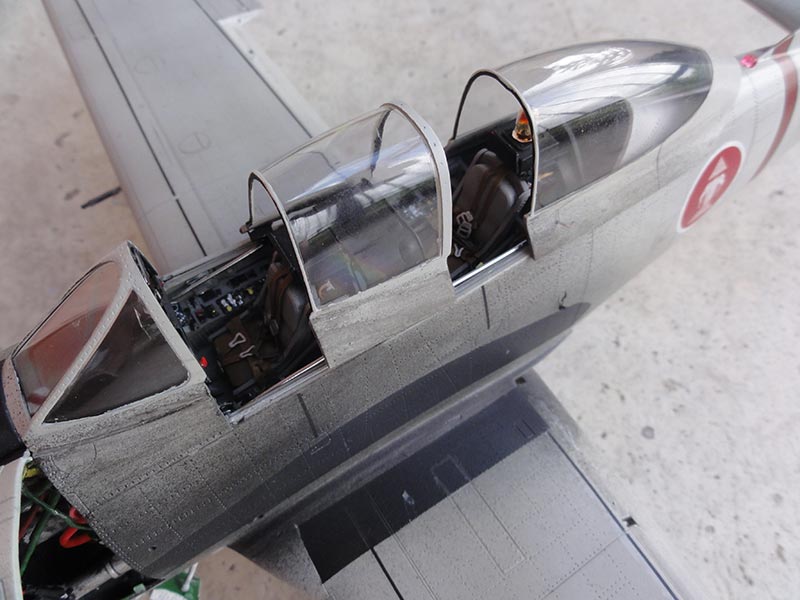

- the pylons as per kit were installed. As the inside pylon stations were not used, the gaps were filled with White Glue and painted white when dried. Note that for the outboard stations a different pylon is also in the kit.
The stores are fine with the kit. I saw that many T-28's in Vietnam carried a wide variety of weapons, even the older types that got retro-fitted with additional pylons over the years. The Air America T-28B carried many loads. I opted to fit two 0.50 gun pods.
For one 0.50 gun pod it was decided to open up the door to access the gun and to re-arm it. For the T-28 gun pod this was seen in the flight manual drawing:
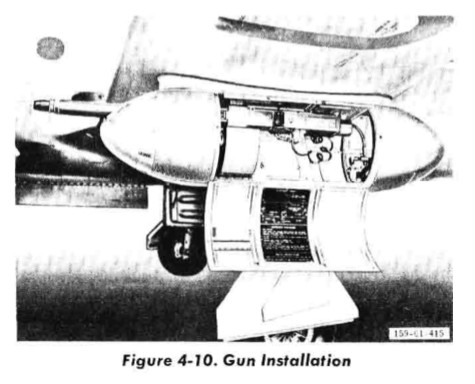
With a razor saw the mid door panel was cut open. Some scrap detail was added for gun and armament belt.
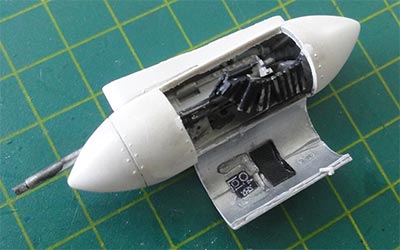
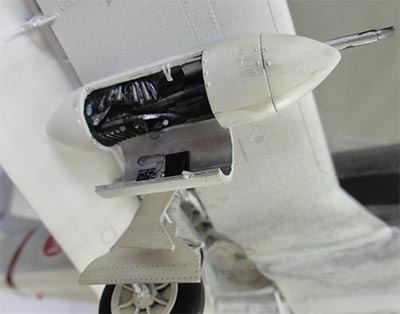
The final T-28 completion steps were:
- adding the various lights. Paints used were transparant TAMIYA colours such as red, green and orange for the wing tips lights, spine lights and the "orange" beacon? light aft of the rear seat. These were all in the kit.
- adding a pitot made from metal bits
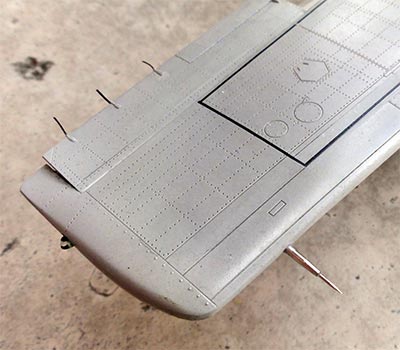
- installing the propeller as per kit; it has white-red-white tip striping and these were airbrushed (so not using the kit decals). I lost the spinner, so made a new one from a part found in the spare box.
Note that prop colours vary on T-28's! Some have a fully black blades whereas others have light grey front blade surfaces and black rear blade surfaces and still others are entirely light grey. So check photos of your desired T-28 in model form. Prop tip colours are yellow or white-red-white.
- the landing lights recesses got 2 bits of blinking glass.
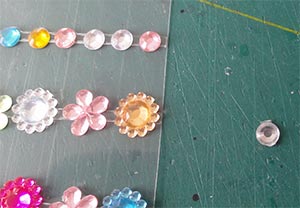

- static dischargers were added made from EZ LINE wire that is flexible. Three at each wing tip, two at stabilizer tip and two at the rudder trailing edge.
- installing the left open cowling door. There is a curved holding bar, this was made from thin metal wire. (The curved bar will fit inside the cowlin when retracted on a real T-28). I also added a few extra wires and pipes at the bulkhead.
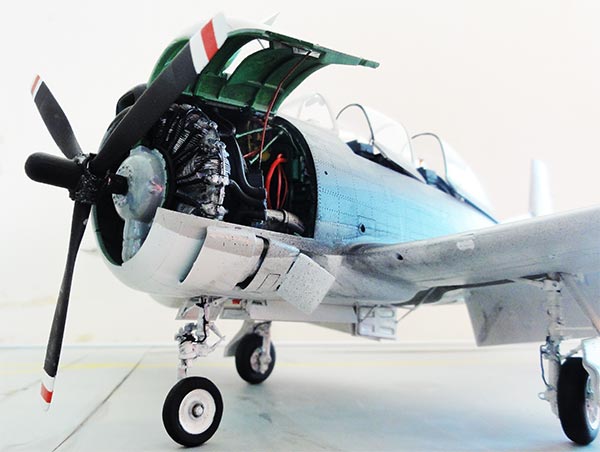
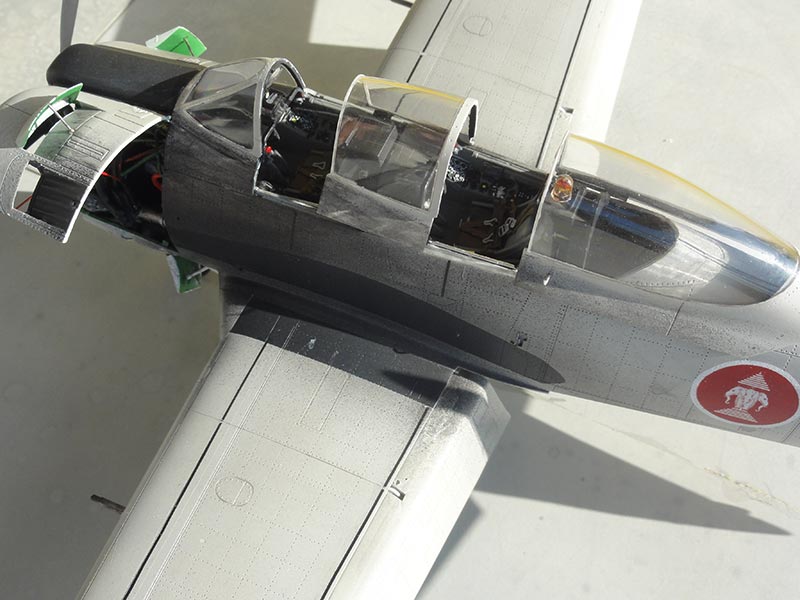
Finally, the whole model got an airbrushed sealing coat of semi matt varnish with Johnson Future/ Pledge mixed with 10% Tamiya X-21 flat base matting agent.
That completed the T-28B model of "Air America".
LAOS

 ....
.... 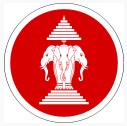
[area: 238,000 sq.km | population: 7,4 million | capital: Vientiane | GDP US 2,000 per capita nominal ]
Laos was a French protectorate from 1893 till 1950, called French Indo-China. In the Second World War the region was occupied by Japan with French Vichy agreement. After the war communist groups such as the Phatet Lao and North Vietnamese army became active in the region supported with Soviet supplied arms to get the French out. France send extra troops from the expeditionary corps including military aircraft. The CIA started to support the leader of the Hmong people leader Yang Pao to fight the communist guerillas. This covert support with US presidential approval was kept fully secret not even known to the US Congres. It lasted almost 20 years before it became more public. Air America was an existing airline established in 1946 in the region but was taken over by the CIA in 1950 to establish air support and for transport tasks.
Laos became in 1950 a France "associated state" but a fully independent monarchy in 1954. In 1954 the last French troops left Laos and the Royal Lao Air Force started with mainly French aircraft. In 1961 T-6 Texans arrived and additional US T-28's. As noted, the CIA was already involved. Between 1960 and 1970, nearly 300 aircraft and helicopters were supplied to the RLAF by the USA and very active was CIA operated "Air America" using DC-3, C-123 and types like the T-28. The Ho Chi Minh trail to support the North Vietnamese army ran also through Laos but the bombing did not stop supplies. Every time, the trail re-routed or repaired to support the Viet Cong troops. So aircraft dropped bombs in Laos often directed to their targets by "Air America" aircraft. On a larger scale B-52's were used, thus not only bombed North Vietman but also Laos. Still, the bombing of Laos was secret, it was thought by the public and US Congress that the bombs were dropped only above Vietnam. Laos became the most heavily bombed country in history given its modest population.
In 1973 the Paris peace agreement was signed in fact stopping most of the Vietnam war. Many RLAF aircraft were flown by their pilots to the Philippines and Thailand. The Laos communist regime from Pathet Lao in 1975 had overran the country and kicked out the Royal Prince Souvanna Phouma. The communist regime continued to use some aircraft of the remaining inventory of over a hundred ex US aircraft ranging from T-28 ground attack to UH-34 helicopters.
The air force was now part of the Lao People's Army
with
Vietnamese and Soviet advisors and known as the "Lao People's
Liberation Army Air Force". Late 1970s the first of 10 MiG-21MF fighters arrived. Other types were Mi-8 helicopters, An-2 and An-26 transports. Eventually
over 40 MiG-21 fighters including some 10 MiG-21MF in
1985 were supplied. From 1983 probably another 20 MiG-21bis were
delivered. For training two seat MiG-21UM were used as well.
In
recent times, the Laos air force operates Mi-17, Ka-2 and a few other
helicopters. The fight regiment flies with Yak-130 armed jets that
replaced the MiG-21 from 2021. The main base is at Vientiane
Wattay.
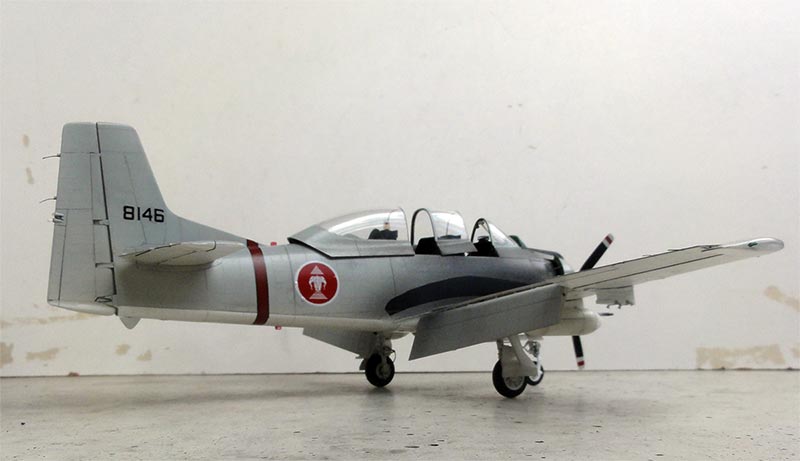
T-28B "8146" of RLAF Laos (operated by Air America 1964/ 1965)


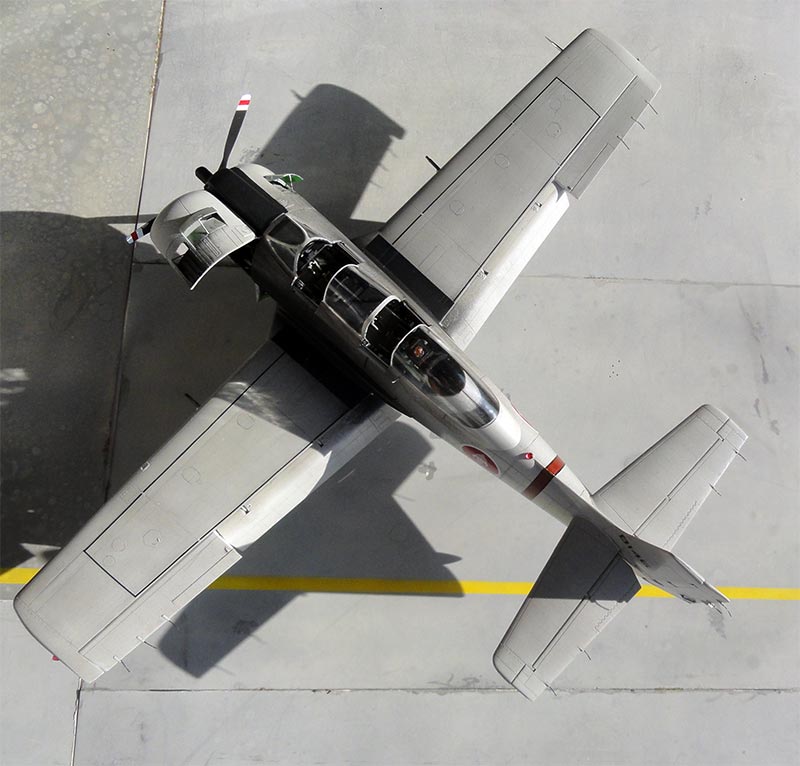
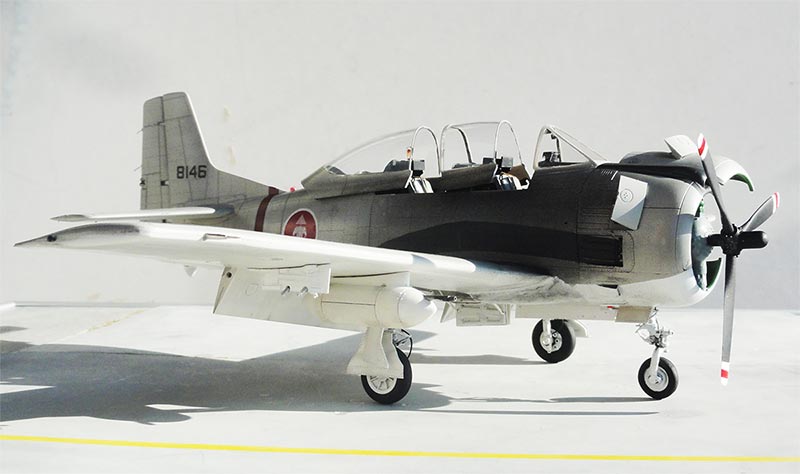
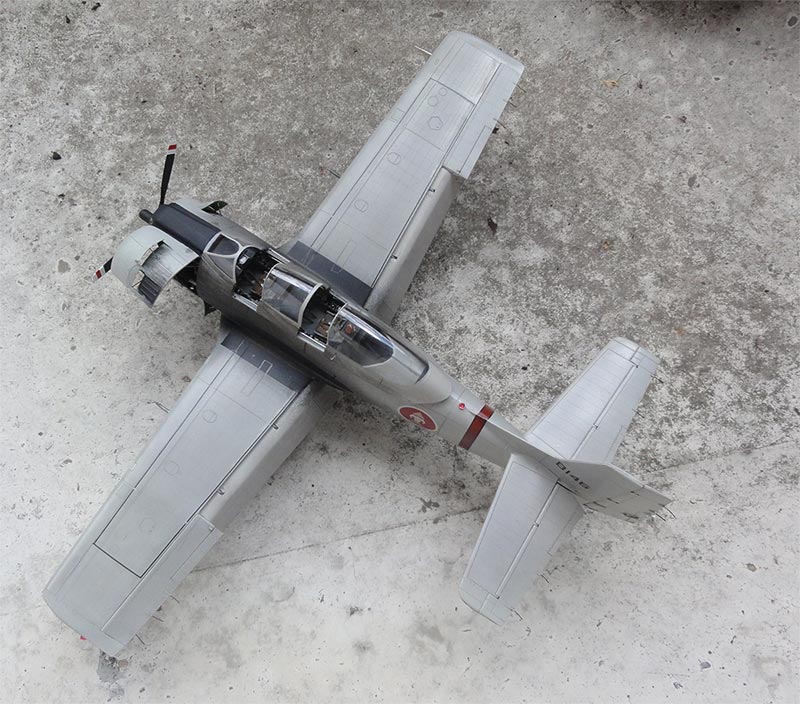
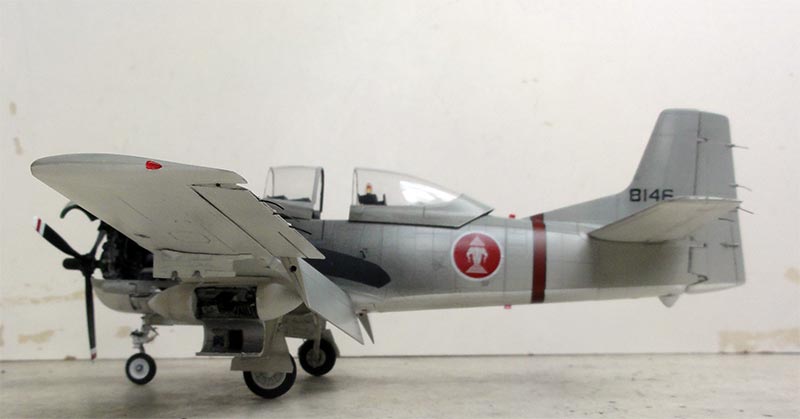
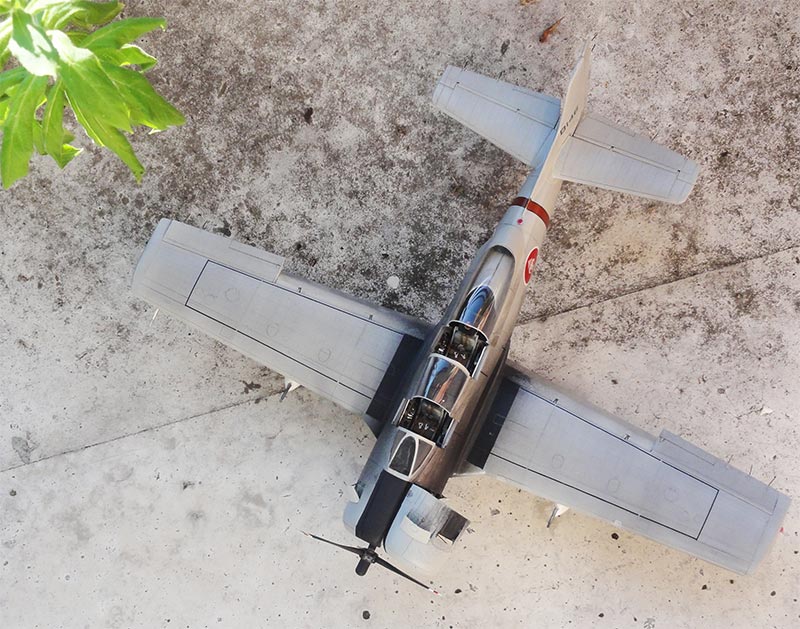
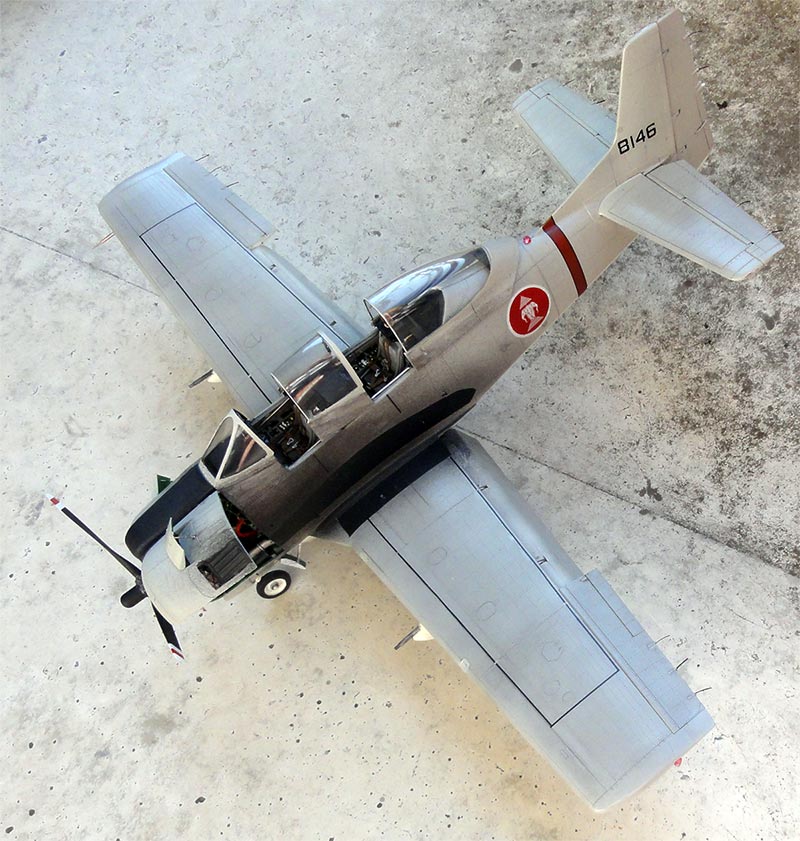
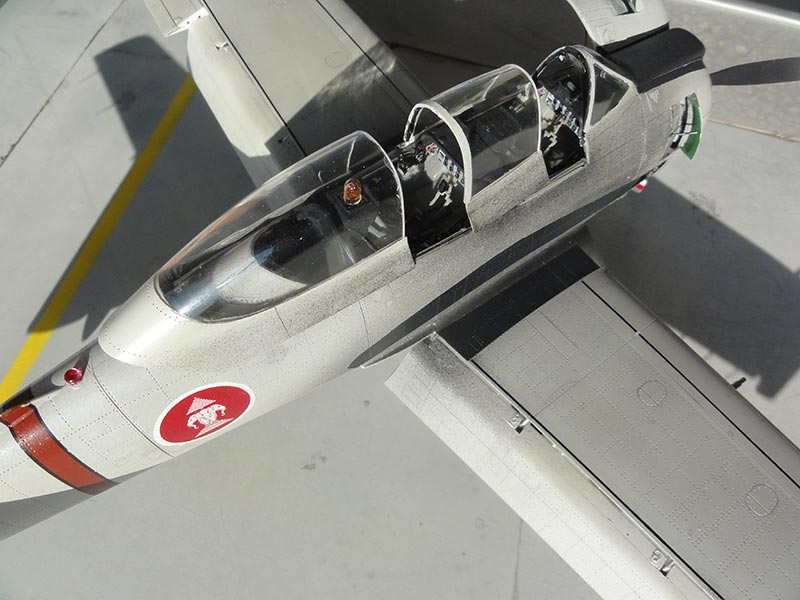
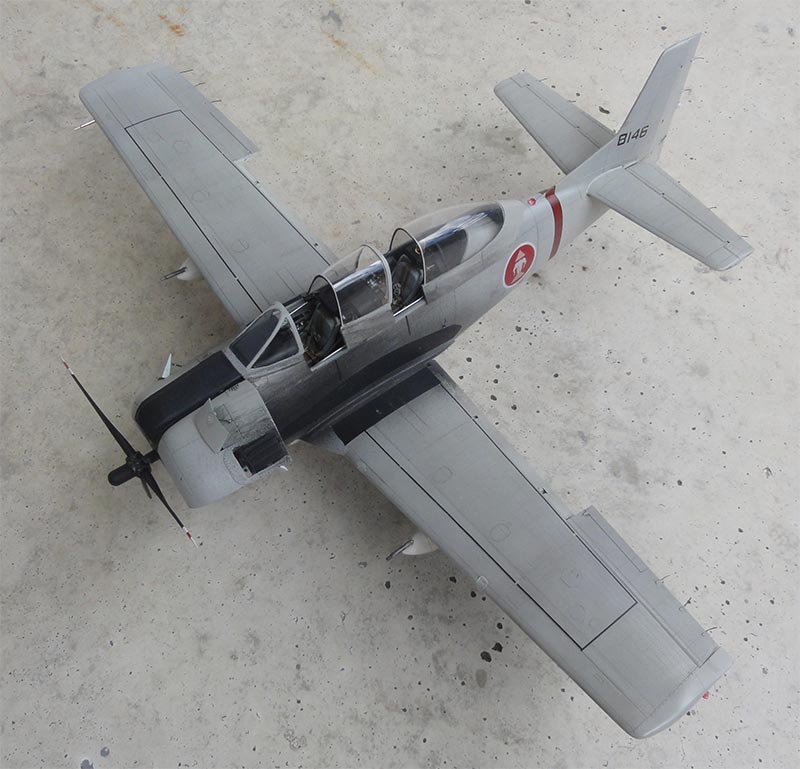
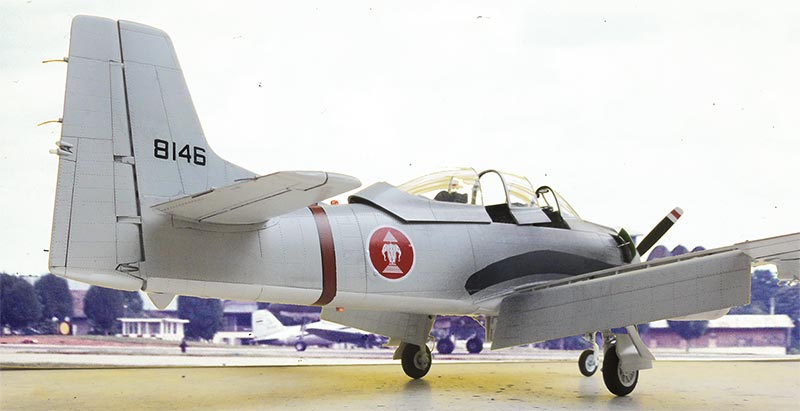
at a jungle air field.....
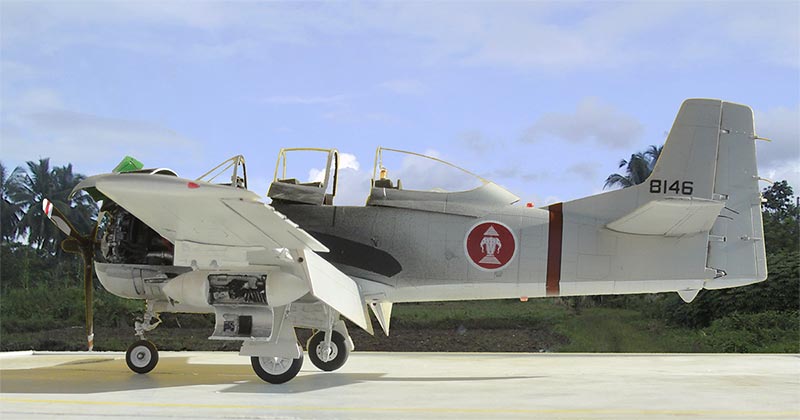
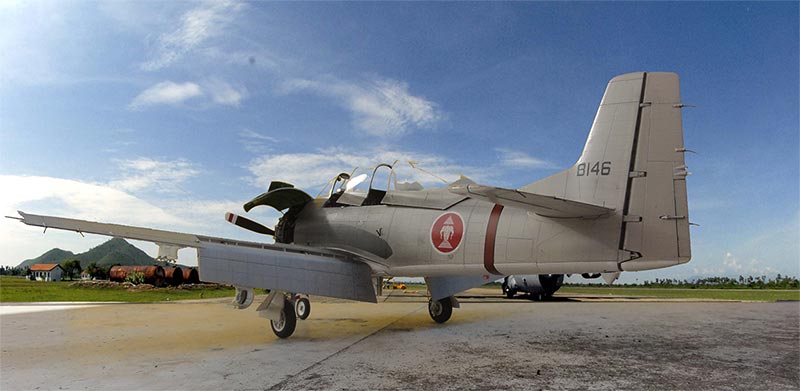
note the C-130 in the background
Back to 1/32 Models.......

(c) Copyright Meindert "designer"/ All rights reserved. Your comments are welcomed by webmaster
Created this page
July 22, 2017